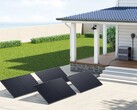The Mohammed bin Rashid Al Maktum solar park currently has a capacity of 2.4 gigawatts and generates one kilowatt-hour of electricity for just about 2.5 cents.
To achieve this, an area of almost 4 square miles had to be fitted with solar panels, which absorb large amounts of sunlight and also heat up. It is obvious that such dimensions have an impact on the environment.
At the University of Hohenheim in Germany, they have therefore done the math. After all, there are sufficiently reliable weather models available that can be used to forecast the complex interplay of heat, air and water.
An area of 6 square miles was used for this, a value that the solar park above is likely to reach shortly. This size is expected to absorb 95 percent of the sun's rays.
Air inevitably rises above such a large and warming area. This creates convection currents, which are responsible for cloud formation. Only one more ingredient is missing: moisture in the air.
And this is exactly what is found in the Persian Gulf, together with winds that bring movement into play in higher layers of air.
As a result, conditions regularly come together that provide 0.4 inches (10 millimeters) of rain over an area around three times the size of the underlying solar surface. In Maine, this would correspond to a very rainy day. In the United Arab Emirates, this is the rainfall of the entire summer.
This positive effect could be used in many regions, taking into account wind direction and available sea areas. Baja California or the coastal region of Namibia, for example, would be similarly dry and located by the sea.
Incidentally, the effect is not inevitable. It can be controlled if you are aware of the effects. There are solar modules that absorb almost all the light. Here, electricity generation and the formation of rain clouds can be combined.
There are also solar panels that completely reflect heat radiation without heating up significantly. Instead, they even offer a cooling effect.
















